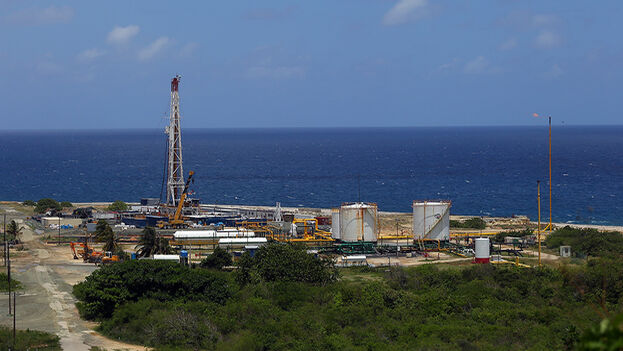
![]() 14ymedio, Havana, 9 May 2023 — The exploitation of the gas deposits of Puerto Escondido, in Santa Cruz del Norte (Mayabeque), goes full-fledged. Energas, the joint venture managed by the Canadian company Sherritt and the Cuban state company Cupet, in addition to Unión Eléctrica, reported on Tuesday that some 200,000 cubic meters of gas are being extracted per day and that production is expected to be doubled in the coming months.
14ymedio, Havana, 9 May 2023 — The exploitation of the gas deposits of Puerto Escondido, in Santa Cruz del Norte (Mayabeque), goes full-fledged. Energas, the joint venture managed by the Canadian company Sherritt and the Cuban state company Cupet, in addition to Unión Eléctrica, reported on Tuesday that some 200,000 cubic meters of gas are being extracted per day and that production is expected to be doubled in the coming months.
However, pollution, gas leaks and the expansion of facilities have been devastating to the town. Interviewed last March by 14ymedio, the inhabitants of Puerto Escondido declared that the air is already unbreathable and that the plague has been poisoning the local flora.
The price that residents have to pay for the activities of Energas seems excessive if one considers the opinion of the managers, who have recognized that they do not achieve a “high production.” The power plant associated with the gas wells of Puerto Escondido benefits by only 30 megawatts, which come from the exploitation of gas in the area, said Eduardo Fernández, facility manager.
In 2000, the Cuban government discovered and decided to exploit “considerable amounts of gas” in Puerto Escondido, reports José Enrique Alegría, director of the Western Oil Drilling and Extraction Company. The town had “oil wells that, after flooding, were used to extract this natural resource,” the manager told the official press.
Then the Puerto Escondido 14 well was opened and, over the years, the Cupet-Unión Eléctrica-Sherrit coalition has drilled other points on the land. “Now we are drilling the Puerto Escondido 200 well, which will further increase electricity generation,” Alegría promised. The installation, according to the manager, will begin operating in June.
Energas directors avoid referring to the environmental damage they are causing, but they do not delay in celebrating the work of their company in terms of “rational use.” “At this time, fuel savings are important in cooking food, since the same fuel used for power generation is also used for cooking,” they say.
In the Puerto Escondido plant, the thermal energy of the gas is converted into electricity by two turbines: one of gas and one of steam. According to Alegría, a “provisional collecting center” was also built in the town to store the gas, as increasing production had exceeded the capabilities of the one that existed before.
Exploiting at all costs this “deep underground site,” as the official press describes the exploitation of Puerto Escondido, involves the installation of “numerous pipes that enter and leave the ground.” Not even the report that Cubadebate dedicated to the plant conceals the impact that the “chimney-shaped towers” are having on the local environment, from which “gases are spit at very high temperatures after the raw material is processed inside the turbine.”
However, the article recognizes that since 1990 the gas emanations were felt in the not so distant Varadero, in Matanzas, and began to annoy tourists. “The northwestern coast, rich in oil fields, put at risk the nascent tourism industry in the area,” the media reported.
Energas was born in that context, under the direct supervision of Fidel Castro, who inaugurated one of its first plants in 2000. At that time the Canadian mining company Sherritt also entered the game. Cuba subsequently contracted a a debt in the million that it now pays with facilities for the extraction of nickel and cobalt in Moa, Holguin.
The goal of Energas, after more than twenty years, is to ensure that it produces “the cheapest electricity in the country,” thanks to the consumption of natural gas in deposits in Havana, Mayabeque and Matanzas.
In any case, the environmental deterioration of the area matters little to the specialists, managers and workers interviewed by Cubadebate, who at no time say they share the alarm of the neighbors not of their own readers of their Energas reports.
“The constant leaking of gas must be completely eliminated,” commented one of the residents, at the bottom of the text. “The smell is perceived in the environment. It is not now, it has been like this for years, and I do not see any action. Review the issue,” he implored the authorities.
____________
COLLABORATE WITH OUR WORK: The 14ymedio team is committed to practicing serious journalism that reflects Cuba’s reality in all its depth. Thank you for joining us on this long journey. We invite you to continue supporting us by becoming a member of 14ymedio now. Together we can continue transforming journalism in Cuba.
